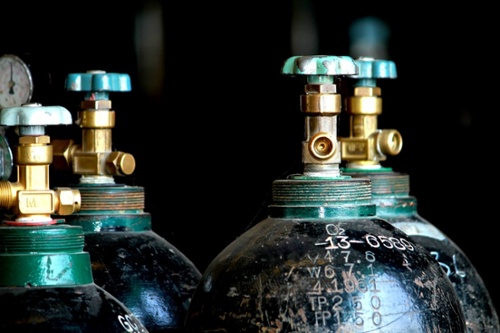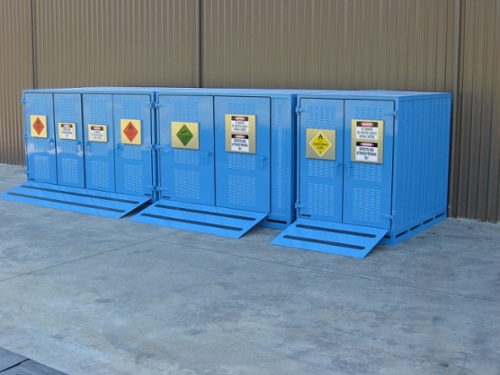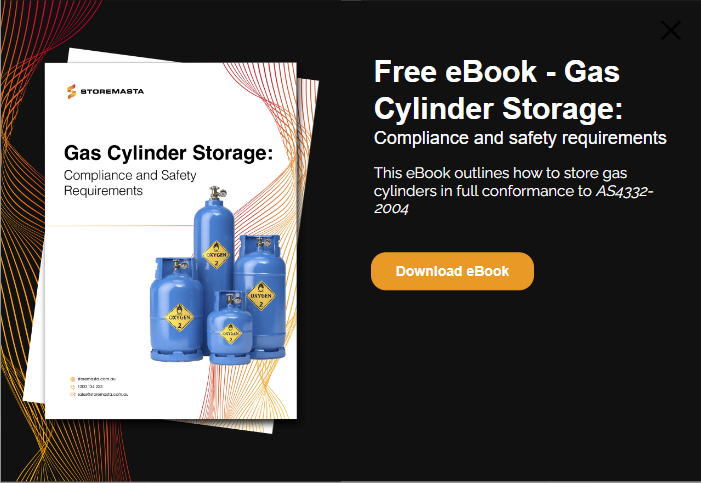Recognised as dangerous goods, compressed gases in cylinders present several known hazards to work areas and job sites. This post takes a brief look at the most common risks associated with each gas hazard class, including flammable gases, non-flammable non-toxic gases, toxic gases and oxidising gases. We’ll discuss what the gas hazards are, why they occur, and how to prevent them. You can use the information provided to support the risk assessment and hazard control measures being implemented for the different classes of dangerous gases at your worksite.
Class 2.1 Flammable Gases (Explosion risks)
Flammable gases are very familiar to us all and are regularly used in the workplace as fuel gases. Class 2.1 Flammable Gases like LPG, acetylene, hydrogen, propane, propylene and methane are easily ignited and potentially explosive.

Acetylene, methane and LPG are just some examples of Class 2.1 Flammable Gases used in the workplace.
Flammable Gas Hazards
Even small gas leaks from pressurised cylinders can cause catastrophic fires and explosions. Leaking gases escape quickly — and when the leak occurs in a room or other confined space that doesn’t have adequate ventilation — the accumulated gas will remain inside its explosive range. Flammable gases like LPG (which are denser than air) present a very high explosion risk because they can travel long distances to ignition sources.
Isolating flammable gases from ignition sources is a requirement of AS 4332 - The storage and handling of gases in cylinders and is achieved by:
- Conducting a full risk assessment of your workplace taking into consideration the dangerous goods present, potential ignition sources, and the possible formation of an explosive atmosphere.
- Keeping cylinders of flammable gases in a dedicated gas cylinder storeaway from incompatible substances and at least 3 metres from industrial heat, refuse, combustibles, and vegetation
- Examine all work activities that involve hot work and flames, or could generate sparks and static electricity
- Train staff in the safe handling of flammable gases (including how to store them correctly when not in use).
Class 2.2 Non-Flammable, Non-Toxic Gases (Asphyxiation risks)
Many people mistakenly believe that Class 2.2 Non-Flammable, Non-Toxic Gases are safe. But inert gases (helium, argon, and neon) plus other non-flammables like nitrogen and carbon dioxide can quickly create an asphyxiation hazard if not stored and handled correctly.
Non-Flammable, Non-Toxic Gases are Recognised as Hazardous Chemicals
The air around us (that we don’t see but breathe) contains 21.1% oxygen (this is what keeps us alive). But if the oxygen content of the air around us drops below 19.5% it puts our lives at risk — we become impaired (can’t carry out manual tasks or think clearly) then pass out, stop breathing, and die.
When Class 2.2 gases leak out into a confined space the oxygen is displaced and the percentage of oxygen in the air is not enough to keep us alive (particularly when there is no ventilation system to dissipate anomalies and maintain the correct percentages). And because many gases are both colourless and odourless, workers entering an oxygen deficient environment have very little warning the area is unsafe.
To minimise asphyxiation hazards, cylinder stores should be well ventilated, so the harmful gases don’t build up within an enclosed store. Gas bottle stores should also be (ideally) located outside, to reduce the likelihood of human harm, fire, explosion and other gas-related hazards.
Adequate ventilation of the gas store is an essential control when dealing with dangerous gases.
Regular inspections on the gas bottles and their valves should be carried out by trained personnel. It’s important to check gas cylinders for leaks, worn thread, loose connections, corrosion, and structural damage. Remember to never accept delivery of a leaking or damaged cylinder, as this can cause an immediate and serious hazard for your workplace.
IMPORTANT: Due to the convenience and economy of gas cages, these compliant stores are often used by businesses to control the hazards associated with various types of gases. Find out more about gas cages and their controls by reading our post, 3 Key Reasons You Need a Gas Bottle Cabinet.
Class 2.3 Toxic Gases (Exposure to toxic substances)
Class 2.3 toxic gases like chlorine, ammonia, hydrogen chloride, fluorine and sulphur dioxide are regularly used in workplaces and industrial job sites — many of these gases are also corrosive.
Toxic Gases are Hazardous Because…
These toxic gases present multiple layers of hazards because the toxicity of the gas is compounded by the pressure in the cylinder, as well as the physical weight and dimensions of the cylinder itself (a cylinder can easily be dropped leading to fatal exposure).
Exposure to toxic gases is extremely dangerous. When toxic gases are inhaled or absorbed by the body they quickly move into the bloodstream and begin to penetrate major organs like our kidneys, lungs and liver.
The severity of physical damage will depend on a combination of factors including:
- The toxic properties of the gas
- The length of time the worker was exposed to the gas
- How quickly they received first aid and treatment
- What other hazardous substances were also present
- Personal health factors of the worker (age, allergies, BMI, smoker/non-smoker)
To avoid severe illness, negative health effects and potentially fatal toxic gas exposure, you must ensure your dangerous gases are handled and stored in a safe and compliant way.
Toxic gases must be stored in a gas cage or store that provides sufficient ventilation to always maintain safe exposure levels. At the same time, workers must be trained to store cylinders upright and keep them restrained (safety straps/chain). When not in use valves must be closed and gas-tight outlet caps or plugs fitted.
REMEMBER: Incompatible gases can react with each other and cause harm to people and property. Always segregate different classes of gases and refer to your safety data sheet for information on incompatibilities.
Class 2.2 (5.1) Oxidising Gases (oxygen enriched environment)
Class 2.2 (5.1) oxidisers are reactive gases that can cause or intensify fires when they come into contact with incompatible substances, heat or ignition sources.
Oxidising Gas Hazards and Health Effects
We mentioned earlier that the air that surrounds us contains approximately 21.1% oxygen, but (in the case of oxidisers) even very small increases to oxygen levels in the air creates an oxygen enriched atmosphere.
In an oxygen enriched environment fires start much easier, burn much hotter and more intensely, and are almost impossible to extinguish. At the same time, this environment is particularly hazardous to workers because static electricity from their hair and clothes can create the fire that leaves them with catastrophic burns and other injuries.
Train staff to handle cylinders containing oxidisers carefully and ensure they are kept upright and always restrained.
Cylinder valves must be opened slowly to prevent frictional heat which can cause a fire or explosion. Only use lubricants, fittings and componentry certified safe for use with oxidisers.
REMEMBER: Heat sources must be kept separate from all types of gas bottles and cylinders. Overheating of gas cylinders can lead to the cylinder rupturing, rapidly releasing compressed gas and creating dangerous shrapnel that can impact those nearby.
Gas Cylinders and Hazard Controls
This post is just a brief introduction to the known hazards associated with common classes of dangerous gases. For a more detailed discussion (including how to apply a tested risk management methodology to control gas cylinder hazards), we recommend downloading our free eBook Gas cylinder storage: compliance and safety requirements. It unpacks the requirements of AS4332 - The storage and handling of gases in cylinders and uses real-world examples to help you relate the legalities to your own worksite.
Joining the team as a Dangerous Goods Storage Consultant, Melissa Hampton became Storemasta's Marketing Manager in late 2021. With extensive knowledge and experience in chemical compliance, Melissa is responsible for leading the Marketing team and helping shape their marketing strategy. In her spare time, you can find Melissa hiking, swimming and enjoying the great outdoors in beautiful north-west Tasmania.

